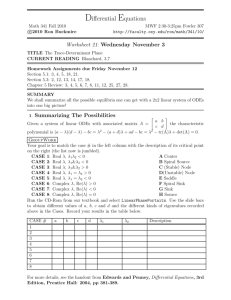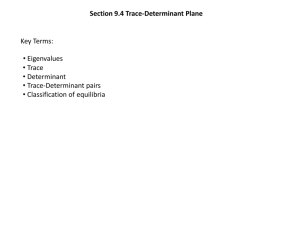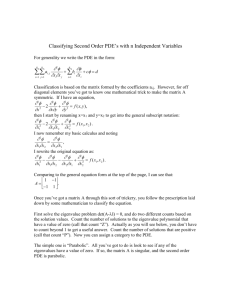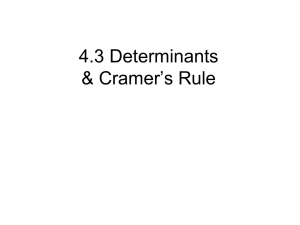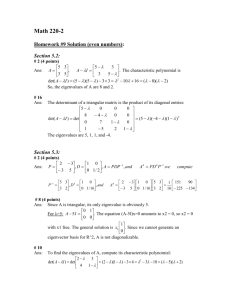Trace-determinant plane, Stability
advertisement
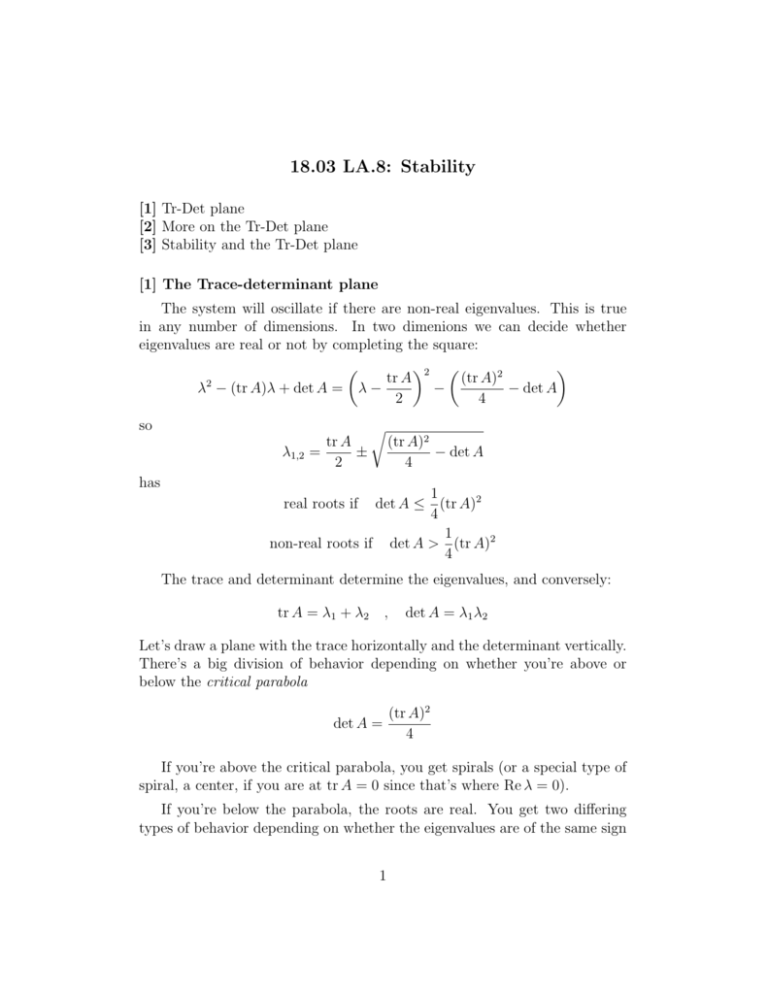
18.03 LA.8: Stability [1] Tr-Det plane [2] More on the Tr-Det plane [3] Stability and the Tr-Det plane [1] The Trace-determinant plane The system will oscillate if there are non-real eigenvalues. This is true in any number of dimensions. In two dimenions we can decide whether eigenvalues are real or not by completing the square: 2 (tr A)2 tr A 2 − det A − λ − (tr A)λ + det A = λ − 2 4 so λ1,2 has tr A ± = 2 r (tr A)2 − det A 4 1 det A ≤ (tr A)2 4 1 non-real roots if det A > (tr A)2 4 real roots if The trace and determinant determine the eigenvalues, and conversely: tr A = λ1 + λ2 , det A = λ1 λ2 Let’s draw a plane with the trace horizontally and the determinant vertically. There’s a big division of behavior depending on whether you’re above or below the critical parabola det A = (tr A)2 4 If you’re above the critical parabola, you get spirals (or a special type of spiral, a center, if you are at tr A = 0 since that’s where Re λ = 0). If you’re below the parabola, the roots are real. You get two differing types of behavior depending on whether the eigenvalues are of the same sign 1 or of opposite signs. Since the determinant is the product, det A > 0 if the eigenvalues are of the same sign, det A < 0 if they are of opposite sign. The big categories of behavior: Spirals if Im λ 6= 0; of angular frequency Im λ = ωd . Nodes if the eigenvalues are real and of the same sign: as in the rabbits example. Saddles if the eigenvalues are real and of opposite sign. 1 0 Here’s a saddle example: A = . This has already been “de0 −1 coupled”: it’s already diagonal. The eigenvalues are +1, −1, with nonzero 1 0 t 1 eigenvectors and . The normal mode solutions are e and 0 1 0 −t 0 e . There are two pairs of ray trajectories, and everything else moves 1 along hyperbolas. You can see how this works out in general using the Mathlet “Linear Phase Portraits.” [2] More about the trace-determinant plane. Let’s look in more detail at these dynamical systems. Start with this unstable spiral and decrease the trace. Remember: the trace is the sum of the eigenvalues, so in this complex case it’s twice the real part. You are making the real part smaller, so the rate of expansion gets smaller and the spiral gets tighter. Question 17.1. If I increase the determinant, 1. 2. 3. 4. The spirals will get tighter The spirals will get looser Neither (but the spirals will change in some other way) Don’t know Well, the determinant is the product of the eigenvalues. In this complex case, the eigenvalues are complex conjugates of each other, so their product is the square of their common magnitude. With fixed real part, the only way that can increase is for the imaginary part to increase. When that happens, you make more loops for a given amount of expansion. So I expect the spirals to get tighter. Let’s see. Yes. 2 As I decrease the determinant, the spirals get looser but also flatter, and if we push all the way to the critical parabola the long direction becomes an eigendirection. This marginal case is called a “defective node.” There’s a repeated eigenvalue but only a one dimensional space of eigenvectors. Any non-diagonal 2 × 2 matrix with a repeated eigenvalue has this property. You can read more about these marginal cases in the notes. If I now move on into node territory, you see the single eigenline splitting into two; there are now two eigenvalues of the same sign. Maybe now is a good time to talk about this box at top right. Fixing the trace and determinant give you two equations. But the space of 2 × 2 matrices is 4 dimensional, so there are two degrees of freedom within the set of matrices with given trace and determinant. They are recorded in this box. Side comment: These alterations are accomplished by replacing A by SAS −1 , where S is invertible. Notice that this doesn’t change the characteristic polynomial: To compute the characteristic polynomial of SAS −1 , we notice that SAS −1 − λI = SAS −1 − SλIS −1 = S(A − λI)S −1 . So, since det(AB) = (det A)(det B), we have pSAS −1 (λ) = pA (λ). So SAS −1 and A have the same eigenvalues; and the same trace and determinant. One thing I can do is rotate the whole picture. (This uses a rotation matrix for S. These are discussed in LA.6) The other thing I can do is change the angle between the two eigenlines. If I look back at the degenerate node, this angle parameter shifts the picture like this. In the middle, you find a “star node”: repeated eigenvalue, but this time you do get two independent eigenvectors. In fact the matrix is diagonal, a multiple of the identity matrix, and every vector is an eigenvector! When we move down to the det = 0 axis, we are forcing one of the eigenvalues to be 0. That indicates a nonzero constant solution. The other eigenline is here. This phase portrait is called a “comb.” A comb is intermediate between a node and a saddle. The saddles behave like the nodes. If I go back up to the spirals, now in the end, you see that the box splits into two parts. As I push up towards the break, I get more symmetric spirals. The upper part is clockwise motion, the lower counterclockwise. You can’t tell which you have from the trace and determinant alone. 3 [3] Stability Here’s the trace-determinant plane again, visible using “Linear Phase Portraits: Cursor Entry.” This plane descibes the various behaviors exhibited by a 2D homogeneous linear system, u̇ = Au. Above the critical parabola det A = (tr A)2 /4 the eigenvalues are non-real and the solution trajectories are spirals. The entire phase portrait is actually called a spiral as well. To the left and right, the eigenvalues are real and of the same sign; the phase portrait is a “node.” Below the axis, the eigenvalues are real and of opposite sign; the phase portraits are “saddles.” (I think this comes from the similarity of this picture with the picture of level sets of x2 − y 2 , from 18.02.) There’s an even more basic dichotomy: Mostly, solutions either blow up or decay to zero. How can we tell which happens? Well the solutions will always involve exponentials with exponents given by the eigenvalues of the matrix. The exponent might be real, it might be complex. But in every case, its growth as t increases is determined by the sign of the real part. Here’s the summary, valid for n × n systems. Unstable: Most solutions blow up as t → ∞: the real part of some root is positive. Stable: All solutions decay to zero as t → ∞: the real parts of all roots are negative. In the 2 × 2 case, we can work this out. If det A < 0, the roots must be real and of opposite sign: unstable. If det A > 0 and the roots are real, they must be either both positive (tr A > 0: unstable) or both negative (tr A < 0: stable). If det A > 0 and the roots are not real, then then Re λ = tr A > 0: unstable; tr A < 0: stable. tr A : 2 so again So in the trace-det plane the stable region is the northwest quadrant only. 4 M.I.T. 18.03 Ordinary Differential Equations 18.03 Extra Notes and Exercises c Haynes Miller, David Jerison, Jennifer French and M.I.T., 2013 1
